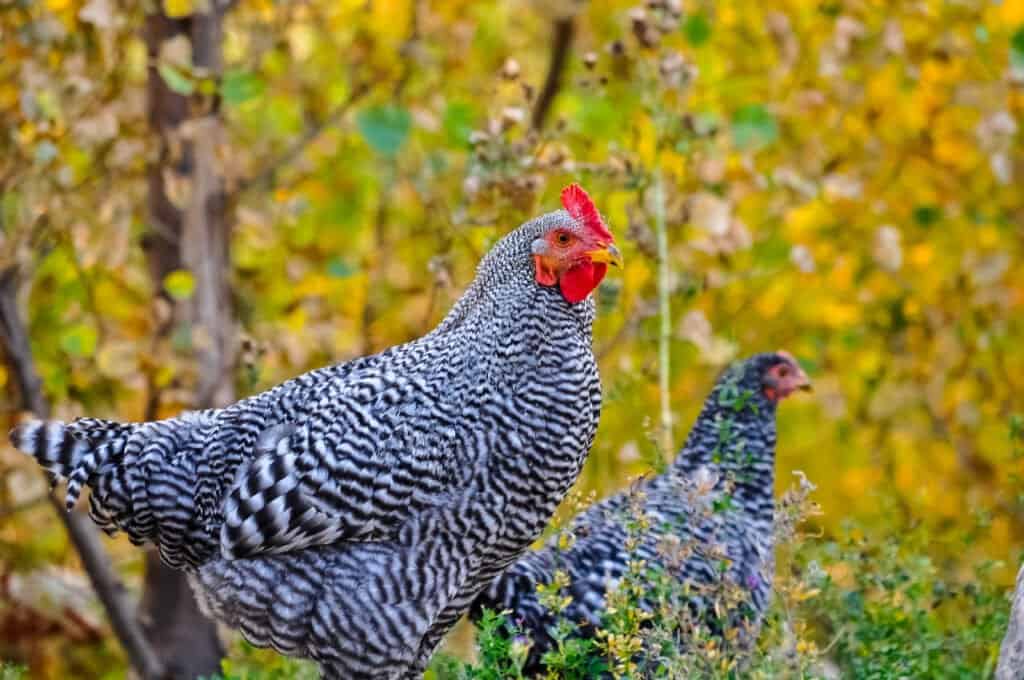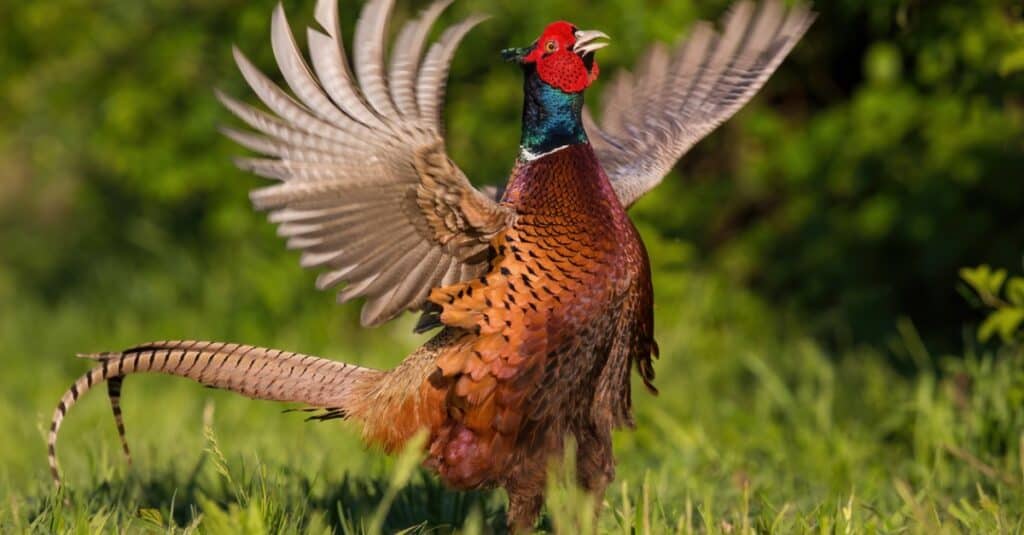The world is home to thousands of bird species, but none are more numerous than the chicken. Incredibly, the chicken has become the most numerous bird on the planet and continues to grow in number each year. What many people don’t know is that chickens didn’t just come from anywhere; they were selectively bred to be what they are today. One of the closest relatives to the modern chicken is the pheasant! Today, we are going to compare a pheasant vs a chicken and see their similarities and differences.
Comparing a Pheasant and a Chicken

| Pheasant | Chicken | |
|---|---|---|
| Size | Height: 23-35 in Weight: 1-7 lbs | Height: 20-30 in Weight: 5-6 lbs |
| Color | Gold or copper plumage. Green or purple neck with a red head. | Dozens of types and colors. |
| Distribution | Native to Asia but has since been introduced into most of the Northern Hemisphere. | Found worldwide. |
| Diet | Mostly seeds | Omnivores. Seeds, insects, small lizards, small snakes. |
| Domestication | Some species are semi-domesticated and released as game birds. | Domesticated from the wild red junglefowl. |
| Population | Bred and released in the millions each year | Over 25 billion alive |
The Key Differences Between a Pheasant and a Chicken
The key differences between a pheasant and a chicken are appearance, diet, domestication, and population.
Pheasants and chickens are similar birds and are quite closely related. Both belong to the Phasianidae family, a group that includes pheasants, chickens, partridges, jungle fowl, turkeys, and quail. These birds are generally characterized as heavy-set ground-living birds, both traits pheasants and chickens display. These two groups split when divided into their genus, however, which is the smallest group before an individual species, showing just how closely related they are. Different species of pheasant belong to different genus groups, but the common pheasant (the one most people refer to) belongs to the Phasianus genus. The chicken is a member of the junglefowl genus known as Gallus.
In initial appearance, it’s clear that these two birds have related ancestry. Still, there are some distinct differences. Chickens are generally larger (due to domestication) and come in more color patterns (also due to domestication).
In regards to domestication, the chicken is likely the most important domesticated animal in the entire world. It provides meat and eggs, both vital sources of protein for the population of the world. The chicken is the most numerous domesticated animal in the world. The pheasant is probably the most widely hunted game bird and is also semi-domesticated, but not to the extent that the chicken is.
Let’s take a closer look at some of these differences in more detail below!
Pheasant vs Chicken: Size

Pheasants have much longer tails than chickens.
©gary noon, CC BY-SA 2.0, via Wikimedia Commons – License
Pheasants are ground-dwelling birds and are relatively large when compared to songbirds. On average, a pheasant is 23-35 inches tall. The tail of a pheasant, when measured from head to tail, makes up a significant portion of its length. Pheasants weigh 1-7 lbs and can vary based on the time of year and age.
Chickens are similar in size to pheasants, although they generally weigh more. Over thousands of years, chickens have been genetically selected to be larger and, in recent years, have been scientifically modified to be so. The exact size of a chicken depends on the breed, but they average 20-30 in tall and weigh 5-6 lbs. In some situations, farm-raised chickens are so overweight they have lost the ability to walk independently.
Pheasant vs Chicken: Color

Chickens come in hundreds of patterns and colors, depending on their breed.
©Jennifer de Graaf/Shutterstock.com
Pheasants are some of the most colorful birds around! There are quite a few species of pheasant, all with their patterns and colorations. Within the group, almost every color can be found, and they are extremely vibrant birds. The common pheasant that most recognize is usually golden yellow and has a green and blue neck with a red eye mask.
Chickens originate from the red junglefowl but have since been bred into different categories. There are dozens of chicken breeds, all with their colors and patterns, although they still belong to the same species. There are about ten defined patterns and a few variations within those patterns. Patterns include self, barred, cuckoo, duckwing, laced, penciled, mottled, spangled, millefleur, black-tailed, black-breasted, and a plethora of others.
Pheasant vs Chicken: Distribution

Pheasants are native to Europe and Asia and have been introduced into other regions.
©iStock.com/JMrocek
The different species of pheasant currently live all over the world. Most of them originate from Europe and Asia, including the common pheasant. Colonizers have since introduced the common pheasant as a game bird into environments all over the world, including some parts of Africa, North America, Australia, and New Zealand.
Chickens are the domesticated version of the red junglefowl, which are native to Southeast Asia. Red junglefowl can be found in Indochina and southern China, Malaysia, Singapore, the Philippines, and Indonesia. After domestication, however, chickens can be found almost anywhere in the world where there are human populations.
Pheasant vs Chicken: Diet

Chickens will eat almost anything.
©Jay-Dee/Shutterstock.com
Pheasants have pretty simple diets that reflect the environments they prefer. Most pheasants’ diets consist of insects, seeds, and leaves.
Part of what makes chickens a great domesticated bird is their diets. Chickens are omnivores and will eat almost anything. They will eat seeds, insects, and even small animals like snakes and lizards if given the chance.
Pheasant vs Chicken: Domestication

Chickens are the domesticated descendants of the red junglefowl.
©Martin Pelanek/Shutterstock.com
The common pheasant is semi-domesticated, although other species still exist in the wild in stable numbers. The primary reason common pheasants are semi-domesticated is due to their use as game birds. They are often bred and raised to adulthood in captivity and then released into the wild before hunting season. The birds are generally considered feral, and the practice is done to sustain numbers during the hunting season.
Chickens are some of the most important animals to have ever been domesticated. Modern chickens are descendants of the red jungle fowl, a bird found in Southeast Asia. Ancient humans could have domesticated chickens as early as 6000 BC in China, with archeological evidence showing it could have been even earlier in Southeast Asia. Part of what made them so useful as a domesticated species was their reaction to unlimited food. When exposed to large amounts of food, red jungle fowl have the disposition to increase their egg-laying. This behavior is likely the result of the bamboo growing cycle, and humans simply hijacked their evolutionary biology.
Pheasant vs Chicken: Population
Pheasants go through large population swings during the hunting season. In the UK, for example, there are 50 million individuals before hunting season begins (many of which are bred and released birds) and only 5 million after. Their population is currently on the decline in the United States.
Chickens are the most numerous birds on the planet, primarily due to farming practices. There are over 50 billion chickens raised each year for meat and eggs, with 74% of the world’s poultry meat coming from factory farms.
The photo featured at the top of this post is © iStock.com/luamduan
Thank you for reading! Have some feedback for us? Contact the AZ Animals editorial team.






